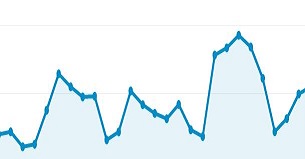Data Has Become Too Complicated!
 When talking with clients and colleagues alike, one of the more popular comments I hear is that people are familiar with web analytics, but don’t consider themselves comfortable enough with the data to really understand what is being presented. I’ve always been fascinated by this response, though I’m certainly not surprised. Anyone can visit their favorite internet marketing publication and see an almost never-ending list of in-depth Google analytics articles on how to really dive into your analytics platform. But how does that help the small-to-medium size business owner who just wants to evaluate site traffic and understand their competition? Let’s remove some of the complications and talk about some basic metrics that can help address the bottom line.
When talking with clients and colleagues alike, one of the more popular comments I hear is that people are familiar with web analytics, but don’t consider themselves comfortable enough with the data to really understand what is being presented. I’ve always been fascinated by this response, though I’m certainly not surprised. Anyone can visit their favorite internet marketing publication and see an almost never-ending list of in-depth Google analytics articles on how to really dive into your analytics platform. But how does that help the small-to-medium size business owner who just wants to evaluate site traffic and understand their competition? Let’s remove some of the complications and talk about some basic metrics that can help address the bottom line.
Keep A Goal in Mind
Don’t just look at Google analytics data for the sake of looking at data. Go into it with a purpose. If you’re interested in how many total visitors came to your site in the last 30 days, look for reports that show exactly that. From there, you can determine how next to proceed. For example, if you are trying to see what your overall traffic looked like in the last 30 days, and you see a small dip last week, you can isolate that time period to see which of your traffic sources dropped. You might find the drop in traffic was a simple, easy fix!
Account for Seasonal Changes

I’ve seen many people notice a slowdown in traffic and immediately panic. This is not always a terrible thing. In fact, it might present an opportunity for a creative paid search or ad campaign. A perfect example is the HVAC industry. If you’re in the South, and the majority of your business centers around home cooling, you can expect a late summer/early fall slowdown in web traffic. This isn’t a problem with your website as much as a seasonal slowdown. Try to counteract that dip with a maintenance promotion or system replacement sale. Or, think about generating chatter with a brand loyalty infograhic. It might not be a blockbuster, but it very well could hold your business over until the busy season arrives. The point is, there might be a perfectly logical reason for a dip in traffic – so use Google analytics to find a creative way to bounce back.
Use More Than One Metric
Individual metrics certainly provide value on their own. But, you can’t always take them at face value. Many times you’ll need to add context to a metric in order for it to make sense. Let’s say that you look at your analytics account one day after making some site tweaks and your bounce rate has gone up and your time on page has gone down. The knee-jerk reaction is trouble. But, take a look at the pages that are causing this change. After the tweak, are users filtering to a contact us page where the call to action is a phone call? If you’ve noticed an increase in phone calls, then the site usage changes might not be that bad. It would appear that users are getting to a call page, making the call, and leaving the site. At the end of the day, you’re getting the conversion. That’s not too bad, right?
The Simple Analytics Solution
The beautiful thing about using web analytics is that you can make the data as complicated as you want it to be. There’s no doubt that taking a really deep dive can unearth some fantastic information. But, make an effort to keep it simple. Not only will the data be easier to understand, but you’ll have better luck in developing your plan of attack on your marketing roadmap.
What tips do you have for navigating and understanding your Google analytics data?


